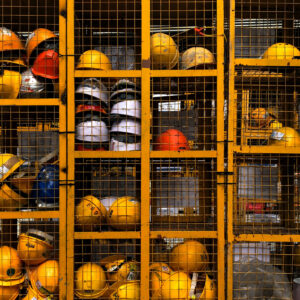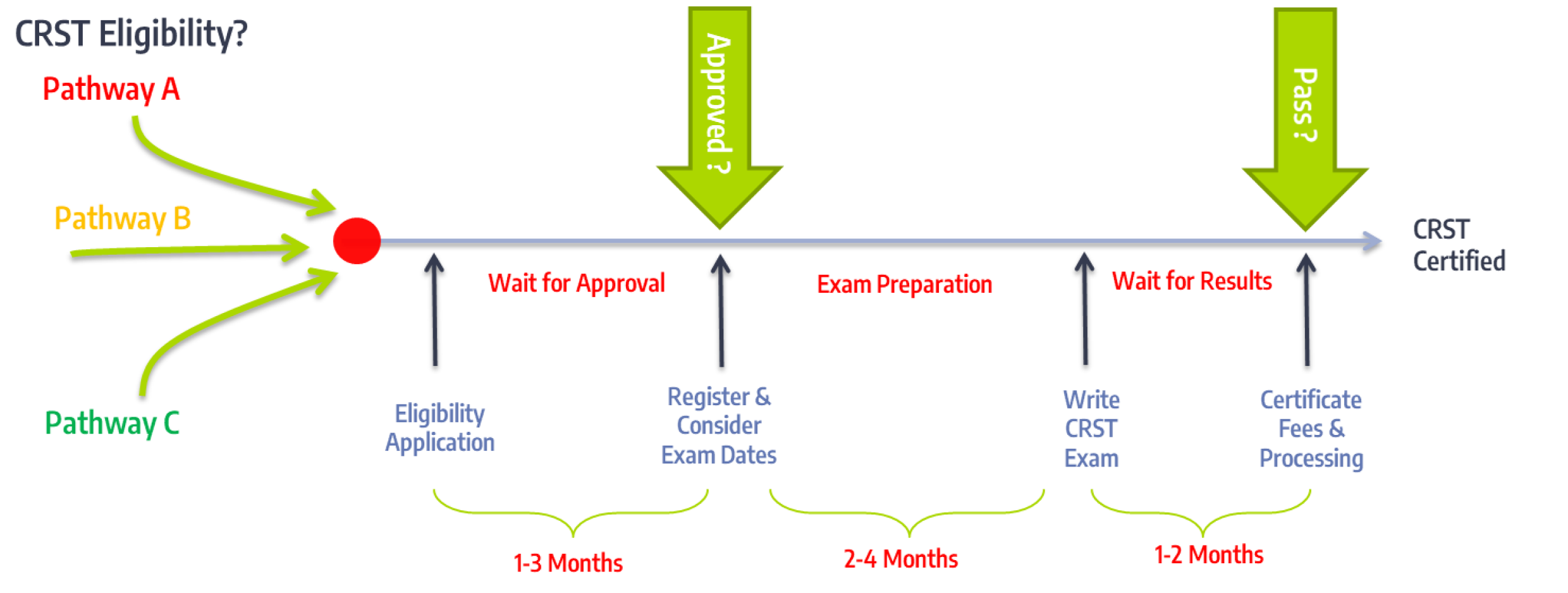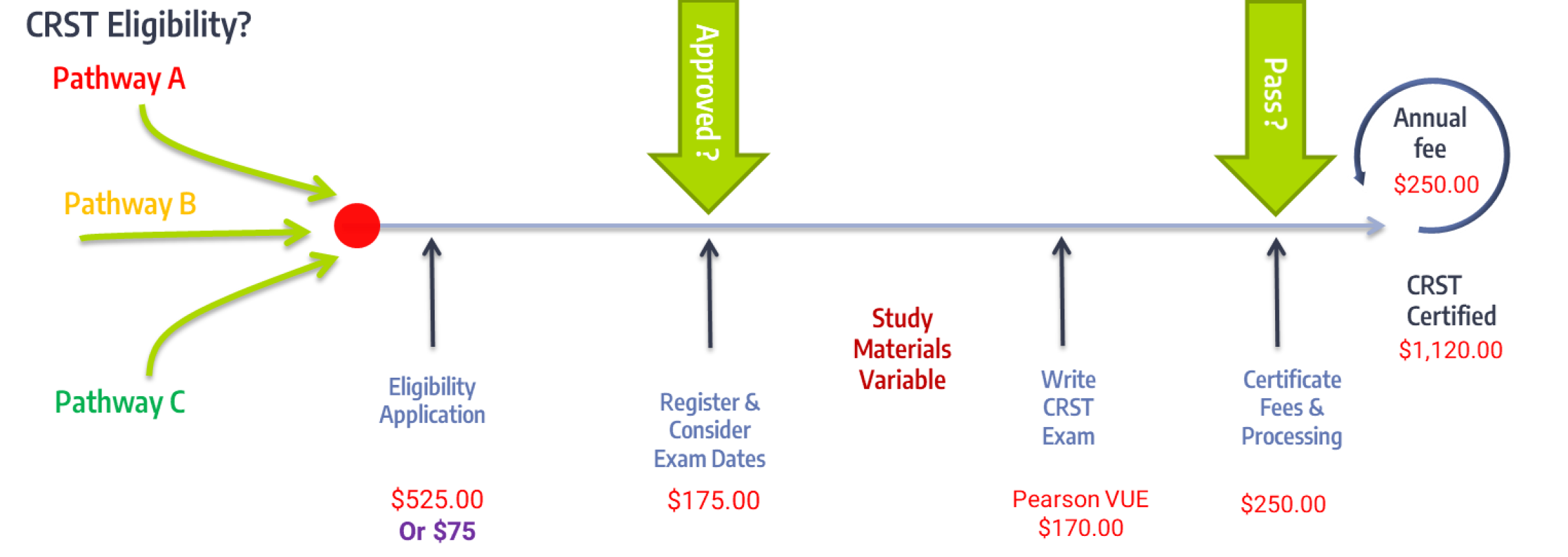 About the CRST
About the CRST
Who administers the exam?
The Canadian Registered Safety Technician (CRST) certification is a widely accepted form of recognition by industry and government in Canada.
This certification is given by the Board of Canadian Registered Safety Professionals (BCRSP), a public interest and not-for-profit association. Founded in 1976, this group is dedicated to the principles of health and safety as a profession. The BCRSP administers occupational health and safety exams and certifies qualified occupational health and safety professionals.
The CRST certification was introduced in 2018 to support the evolving needs of the industry. CRSTs are responsible for supporting and implementing the operational health and safety systems created by Canadian Registered Safety Professionals (CRSPs). CRSTs use the adopted and tailored tools that are approved by CRSPs in order to assess and monitor risks to ultimately increase productivity. (Visit this page to better understand the differences between the CRST and CRSP.)
What exactly does a CRST do?
According to the BCRSP, a CRST supports a safe working environment by maintaining OHS administrative processes, conducting training and using a range of state-of-the-art tools, processes and common practice solutions to OHS risks. They oversee and drive monitoring and compliance in relation to technical and behavioral risk controls. The role and expectations of a CRST are:
- Implementer/executor of OHS management systems.
- Developer and implementer of the tactics to support existing strategies.
- Communicates with relevant parties, building relationships as a basis for influence, mentoring and providing technical advice.
- Supports safe working environment by maintaining administrative processes, conducting training, and using state-of-the-art tools, processes, and standard practice solutions.
- Focuses on organization’s primary processes operating in known contexts within established parameters.
- Accesses, evaluates, and uses a broad range of workplace and industry sources of information.
- Advice/action based on technical knowledge, experience, and input by other OHS professionals and subject matter experts.
- Strives to continually improve one’s organization and self.
- Understands and operates within the boundaries of the CRST scope of practice.
Who qualifies for the CRST?
To qualify for the certification, you’ll be required to meet qualification standards, including education and experience requirements. At minimum, candidates should have successfully completed a bachelor’s degree in any field or a 2-year diploma or certificate with a minimum of 900 hours or 60 credits in occupational health and safety (OHS) or equivalent from a recognized academic institution (e.g. Toronto Metropolitan University).
It should be noted that for candidates who apply with a bachelor’s degree, they must demonstrate sufficient professional development in OHS to qualify.
This includes 48 months of professional level OHS experience obtained within the last 72 months, which also means a minimum of 900 hours per calendar year of practice in OHS. (Note: requirements may change or be updated year to year. Check the official BCRSP website for the most accurate information.)
How do you get certified for the CRST?
Let’s begin by going through this timeline below, which outlines the CRST certification process. It starts with the CRST eligibility process, followed by the application and registration processes, writing the CRST exam, and finally concluding with the completed certification.
Don’t forget to check out our crash courses!
Take control over your career.

Let’s break down each step and take a closer look.
Step 1: Eligibility
To begin, looking at the eligibility criteria, candidates can choose three different pathways to apply for the CRST.
Pathway A is for those who have successfully completed a one-year OHS certificate program from a recognized educational institution (for example, Toronto Metropolitan University). They should also have at least twelve months of OHS work experience with at least 35% OHS duties immediately before submitting an application. Just to give you an example, let’s say you are an HR manager in your current workplace and as a part of your job description, you deal with health and safety matters in your workplace, things like return-to-work procedures, OHS training, rewarding for safety, and many other tasks. Although your organization already has a separate OHS manager, you could say that overall, you spend 35% of your job supporting the OHS department. (Note: the required OHS experience must total to 12 months and have been obtained over the previous 24 months as validated by the Qualification Review Committee.)
Pathway B requires candidates to have completed a two-year (equivalent to 900 hours or 60 credit hours) non-OHS formal education program from a recognized educational institution OR have achieved journeyman status in a trade. These candidates should have completed professional development courses or training related to the CRST Examination Blueprint competency categories from health and safety management to ergonomics, industrial hygiene, fire safety, machine safety, and many others before submitting an application. They should also have obtained a minimum of twelve months OHS work experience with at least 35% of it being related to OHS duties. Similar to pathway A, the OHS experience must be total to 12 months, and have been obtained over the previous 24 months.
Pathway C is for graduates of OHS programs from a recognized educational institution. These candidates do not require previous experience and they are eligible to write the CRST certification exam immediately upon graduation. The program must be on the approved list published by BCRSP so please make sure to verify. There are two key differences between pathway C and the others. First is that they do not require any workplace experience; and second upon obtaining 4 years of relevant OHS experience at a professional level, these candidates will be eligible to apply for the CRST certification. This is because pathway C has a greater education-based requirement in comparison to A and B.
Step 2: Apply for Eligibility
Once you determine whether you are eligible, you should submit your application to the BCRSP who will review your profile and determine whether or not you qualify to write the mandatory certification examination.
For applicants whose first language is neither English nor French, they must submit documentation verifying proof of language proficiency. International applicants may also provide additional documentation, such as academic credentials that have been translated to English or French and can be verified by an official translator. International credentials must be submitted to a Canadian Credentialing Agency prior to application submission.
Once your eligibility has been determined and the required documentation has been prepared, you are ready to apply! Applicants must complete an application form and submit it along with all supporting documentation. They will be required to pay a non-refundable application fee to the BCRSP for processing. The application form requires details concerning formal education, professional development, and related experience. In addition, a reference questionnaire and practice questionnaire must be completed by individuals who have a sound knowledge of the applicant’s work performance, such as a direct employer or manager. It’s important to ensure that all information submitted in the application along with any required documentation is accurate without any errors. Make sure that you review the eligibility requirements before submitting an application as the application fee is non-refundable. You should complete all the forms properly to avoid any delay.
Step 3: Further Waiting
After submitting your application, your file may be selected for an interview. These are usually hosted by Regional Screening Committee volunteer(s) who is a certified CRST. A volunteer certified CRST will contact you to mutually arrange a time and a location, depending on where both parties are located.
From the time of submission, it will take roughly three to five months to hear back from the BCRSP. During this time, their offices will go through all your documentation and perform the necessary due diligence required. A common question our team receives is “why does the process take so long?” The answer is simply that there’s several steps which the BCRSP has to go through to verify your documents, confirm your references, and process the information. Therefore, to reiterate this one more time, in order to streamline the experience, ensure that all aspects of your application are complete before submitting! Once a candidate has been approved to take the examination, they will be sent an examination authorization email with the exam scheduling information.
Step 4: Approval
After being approved to sit the CRST examination, applicants have twelve months to make their first attempt. However, following the first attempt, they will only have another 12 months for the second and third attempts in case they do not achieve a passing grade. This is very important to consider when planning for your exam. Remember that the dates for writing the CRST exam can vary. There are usually 3 testing periods throughout the year as listed on the slide, but make sure to check the BCRSP’s official schedule for accurate times.
Step 5: Consider the Right Exam Date
You might decide to write the exam either immediately or at the end of the 12-month window. In terms of when would be the best time to sit the exams, it’s really up to your preparation, schedule, and the exam center availability. Check out this blog post for more details on how to pick the right exam date.
Step 6: Register for an Exam Date
The best advice for anyone who is planning to write the CRST exam is to set a date congruent with your schedule and register (including paying an exam registration and exam centre fee). After taking some time to consider your individual timeline and how comfortable you are with the content, setting a date and following through by registering is the perfect way to stay accountable as it sets a deadline for you to work towards.
Remember, the BCRSP application process takes roughly 1 to 3 months. Most candidates take on this certification alongside their work or other full-time commitments, so it’s easy to forget about it and set it aside when convenient. Tip: by selecting and committing to an exam date early on, you give yourself a fixed target to keep in mind as you study.
Step 7: Exam Preparation
Create an exam preparation strategy that works. Consider the various aspects of the preparation process, including: how to approach and structure your study plan, what competencies you will be required to know, exam details and references, the preparation time frame, studying methods and recommendations, and how our CRST Exam Crash Course can provide you with a proven and tested method of achieving your goals.
Learn more about how to create the right exam preparation strategy for you.
Step 8: Write the Exam and Wait for the Results
All the examinations are written via Computer Based Testing (CBT). Following the exam, it usually takes 2 to 3 months for candidates to receive their results. (Tip: make sure to factor these gaps into your plan!) Once you get your passing results, it’s time to celebrate! You’ll also have to pay $250 for certification fees and processing, and this fee will renew annually at the beginning of each year after the first year.
If you don’t pass, it’s time to contact us to create a custom study plan for you to try again.
How much does this exam cost?
The eligibility application is about $525, unless the applicant has other similar designations such as CSB or NEBOSH from other countries, in which case they will pay only $75. Each exam attempt will cost $175 for registration as well as approximately $170 for exam centre fees. After passing the exam, candidates will be required to pay $250 for certification fees and processing, and this fee will renew annually at the beginning of each year after the first year. Thus, the overall CRST examination process costs on average $1,120.






